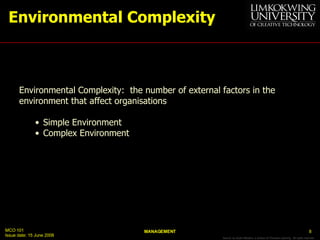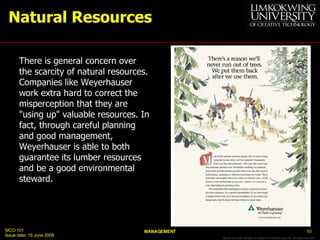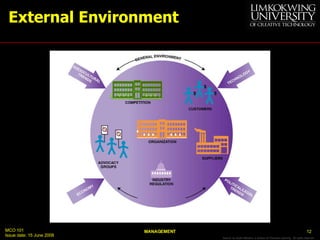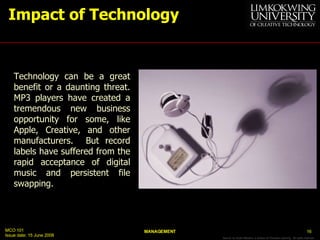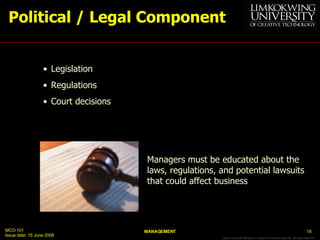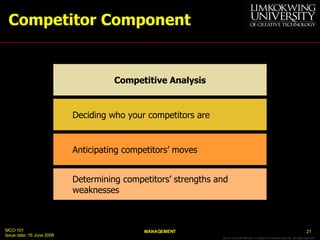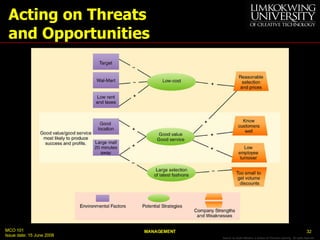MBA MCO101 Unit 3 Lecture 4 20080622
- 1. Unit 3: Organisation, Globalisation and the resulting environments
- 2. Managing Expectations LEARNING OUTCOMES: At the end of the course, students will be able to: Explain fundamental concepts and principles of management including the basic roles, skills, and functions of management Discuss the knowledgeable of historical development, theoretical aspects and practice application of managerial process Examine the environment, technology, human resources, and organisations in order to achieve high performance Discuss the ethical dilemmas faced by managers and the social responsibilities of businesses.
- 3. Managing Expectations SUBJECTS DISCUSSED: Management, Managers and evolution of Management theory Personality traits and diversity Organisation, Globalisation and the resulting environments Decision-making and Planning Structure and Strategy Executing and Controlling Human Resources Management as a function Motivation, Leadership, Groups and Teams Communication, conflicts and politics Operations Management. Entrepreneurship. Innovation
- 4. Managing Expectations TOPIC DETAILS: After going through UNIT 3, you should be able to: Discuss how changing environments affect organisations. Describe the four components of the general environment. Explain the five components of the specific environment Describe the process that companies use to make sense of their changing environments. Explain how organisational cultures are created and how they can help companies be successful
- 5. Changing Environments Environmental Change Environmental Complexity Resource Scarcity Uncertainty Characteristics of Changing External Environments
- 6. Environmental Change Environmental Change is the rate at which a company’s environments change, stable environments dynamic environments Punctuated equilibrium theory: Companies cycle through stable and dynamic environments.
- 7. Punctuated Equilibrium: U.S. Airline Industry
- 8. Environmental Complexity Environmental Complexity: the number of external factors in the environment that affect organisations Simple Environment Complex Environment
- 9. Resource Scarcity Resource Scarcity The degree to which an organization’s external environment has an abundance or scarcity of critical organisational resources
- 10. Natural Resources There is general concern over the scarcity of natural resources. Companies like Weyerhauser work extra hard to correct the misperception that they are "using up" valuable resources. In fact, through careful planning and good management, Weyerhauser is able to both guarantee its lumber resources and be a good environmental steward.
- 11. Uncertainty
- 13. Components of the General Environment Economy Technological trends Sociocultural trends Political / Legal trends
- 14. Economy Growing vs. shrinking economies Predicting future economic activity Business confidence indices
- 15. Technological Component Information Output Input Technology-- Knowledge Tools Techniques Raw Materials Services Products
- 16. Impact of Technology Technology can be a great benefit or a daunting threat. MP3 players have created a tremendous new business opportunity for some, like Apple, Creative, and other manufacturers. But record labels have suffered from the rapid acceptance of digital music and persistent file swapping.
- 17. Socio-cultural Component Socio-cultural Components Demographic changes Changes in behavior, attitudes, and beliefs
- 18. Political / Legal Component Legislation Regulations Court decisions Managers must be educated about the laws, regulations, and potential lawsuits that could affect business
- 19. Specific Environment Customer Competitor Supplier Industry Regulation Advocacy Group
- 20. Customer Component Monitoring customer wants and needs is critical for business success Reactive customer monitoring: responding to problems, trends, and events Proactive customer monitoring: anticipating problems, trends, and events
- 21. Competitor Component Competitive Analysis Deciding who your competitors are Anticipating competitors’ moves Determining competitors’ strengths and weaknesses
- 22. Supplier Component Opportunistic Behavior Suppliers Buyer Dependence Supplier Dependence Relationship Behavior
- 24. Industry Regulation Component Industry Regulation Consists of regulations and rules that govern the business practices and procedures of specific industries, businesses, and professions. Identify and discuss relevant regulatory agencies that affect business practices.
- 25. Cost of Compliance Researchers studied U.S. manufacturers and the cost they incur complying with the 25 major federal regulations. Researchers found: There are about 300,000 manufacturing companies in the U.S. Each company spends roughly $2.2 million So, the aggregate cost of complying with federal regulations is roughly $660 billion And that’s just for manufacturing.
- 26. Dealing with Gifts and Suppliers Guidelines to Avoid Conflicts of Interest There’s no such thing as a free lunch Meals and entertaining are valid business No gifts worth more than $25 in value No cash or cash equivalents No discount on goods and services No stock in suppliers’ companies Don’t allow personal friendship to influence decisions
- 27. Advocacy Groups Groups of concerned citizens who band together to try to influence the business practices of specific industries, businesses, and professions Techniques to try to influence companies public communications media advocacy product boycotts
- 28. Advocacy Groups Examples The Body Shop has emphasised its support for a wide range of issues around the globe. Its slogans included: Against Animal Testing, Support Community Trade, Activate Self Esteem, Defend Human Rights, and Protect Our Planet. PETA is a well-known advocacy group that attempts to influence consumers and companies to pursue animal-friendly practices.
- 29. Making Sense of Changing Environments Acting on Threats and Opportunities Interpreting Environmental Factors Environmental Scanning Evaluating External Environments
- 30. Environmental Scanning Environmental scanning: searching the environment for events or issues that might affect an organisation keeps companies current on industry factors reduces uncertainty alters organizational strategies contributes to organizational performance Interpreting the scans into opportunities and threats
- 31. Acting on Threats and Opportunities Cognitive Maps simplified models of external environments depicts how managers believe environmental factors relate to possible organisational actions
- 32. Acting on Threats and Opportunities
- 33. Internal Environments Consists of the trends and events within an organisation that affect the management, employees, and organisational culture important because it affects what people think, feel, and do at work organisational culture is the set of key values, beliefs, and attitudes shared by organisational members Creation & Maintenance of Organisational Culture Organisational Heroes Organisational Stories Company Founder
- 34. Successful Organisational Cultures Employee Satisfaction Quality Consistency Adaptability Involvement Clear Vision Sales Growth Return on Assets Profits
- 35. Levels of Organizational Culture Symbolic artifacts Behaviors 1. Surface Level SEEN What people say How decisions are made 2. Expressed Values and Beliefs HEARD Beliefs and assumptions Rarely discussed 3. Unconsciously Held Assumptions and Beliefs BELIEVED
- 36. Changing Organisational Cultures Behavioral addition : is the process of having managers and employees perform a new behavior Behavioral substitution : is having managers and employees perform a new behavior in place of another behavior Change visible artifacts : such as the office design and layout, company dress codes, etc.
- 37. What Would You Do? Wendy’s International Headquarters Obesity is at epic proportions, with 66 percent of Americans overweight Fast food restaurants are faced with lawsuits, regulation, and complaints Healthier cooking techniques costs more with less tasty results Should Wendy’s pay attention to activists or give customers what they want? Your opinion please…








